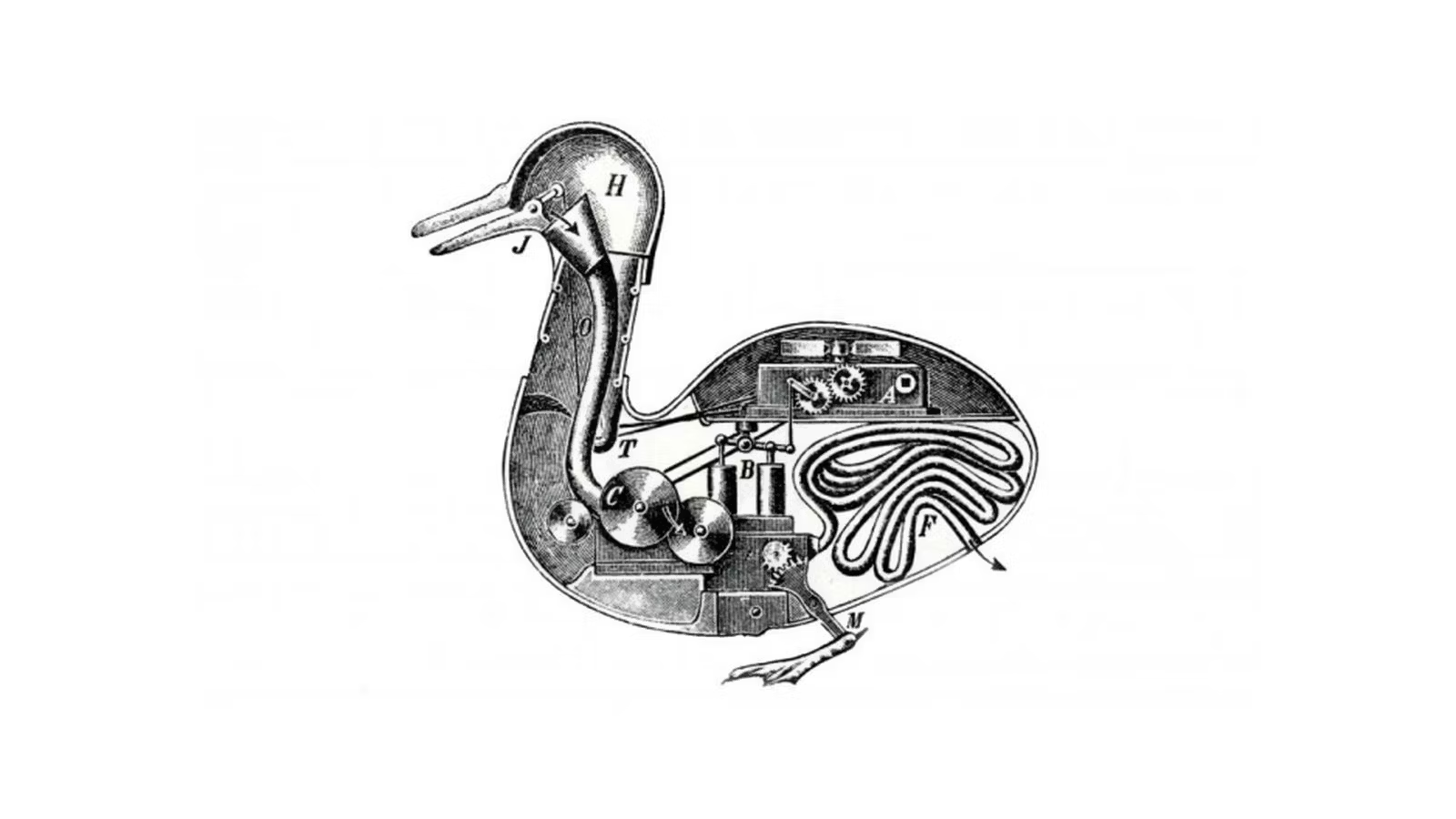2024 Spring Semester
한국예술종합학교
미술원 건축과 예술전문사 과정
Korea National University of Arts
Department of Architecture / Graduate School

Digesting Duck (1764) by Jacques de Vaucanson
강의 요강 syllabus
(English below)
건축의 역사는 인류가 자연을 인식하고 관계 맺는 방식과 긴밀하게 연관되어 있다. 거친 ‘자연’에서 보호하기 위해 집을 짓고, 또 풍경으로서의 ‘자연’을 실내로 끌어들이기 위해 창을 만드는 것처럼 건축의 방법과 형태, 기능과 미감은 자연과의 관계 속에서 정의되고 변화되어 왔다. 그러나 자연은 고정된 개념이 아니라, 시대에 따라 의미가 변화하고, 문화적으로, 사회적으로 구성되는 역동적인 것이다. 건축에서 자연은 야생의 공간, 도피처이자 영감의 원천으로, 때로는 아름다운 배경으로, 또 20세기에 들어서는 건축이 파괴하는 것으로 다양하게 해석된다.
건축비평론세미나 1은 자연을 바라보는 이러한 다양한 관점을 탐구하여 이를 통해 건축을 읽고 실천하는 도구로 사용하는 연습을 한다. ‘자연’의 개념은 방대하기에 다섯 가지의 선별적인 주제에 따라 예시적인 접근 방법을 취하며, 각 주제에 해당하는 문학, 자연 과학 등 건축 바깥의 담론과 실제 건축 프로젝트를 횡단하며 읽어나간다. 자연과 도시/건축을 분리된 것으로 바라보는 뿌리 깊은 이원론에서 최근의 포스트 휴머니즘 담론에 이르기까지, 다양한 자연관을 탐색하고 이렇게 학습한 담론내용과 연구기법들을 비판적으로 발전시켜 본인의 이론/개념 틀을 구축해 논문/설계 작업의 바탕이 되는 비판적 태도로 발전시키는 훈련을 하는 수업이다.
The history of architecture is intimately intertwined with how humans perceive and interact with ‘nature’. Much like how houses are built to protect us from the wild ‘nature’ outside and windows are designed to bring elements of ‘nature’ into indoor spaces, architecture has evolved in response to our relation to the natural world. However, ‘nature’ is not a fixed concept; it is culturally and socially constructed, meanings of which have changed throughout history. In architecture, ‘nature’ is interpreted in various ways: as wilderness, a refuge, a source of inspiration, and sometimes as a platform for aesthetic expression, or even as something that architecture may destroy.
Seminar on Architectural Criticism 1 explores these diverse perspectives on ‘nature’ as analytical and generative tools for interpreting and practicing architecture. Given the wide-ranging nature of the subject, the course focuses on five selected topics. This approach facilitates a deep dive into each area, enabling a transdisciplinary reading that connects architectural projects with fields such as natural science, social studies, and literature. Through this method, students engage with a variety of viewpoints, from traditional binaries of nature and culture to contemporary post-humanist discourses. The goal is to develop theoretical and conceptual frameworks that students can apply to their research and design projects.
Course Reading
Anker, P. (2010). From Bauhaus to ecohouse: A history of ecological design. Louisiana State University Press.
Colomina, B., & Wigley, M. (2016). Are We Human?: Notes on an Archaeology of Design. Lars Mul̈ler Publishers.
Marris, E. (2013). Rambunctious Garden: Saving Nature in a Post-Wild World (Reprint edition). Bloomsbury USA.
Harari, Y. N. (2015). Sapiens: A Brief History of Humankind (Illustrated edition). Harper.
임석재. (2011)임석재의 생태건축. 인물과 사상사
Tsing, A. L. (2015). The mushroom at the end of the world: On the possibility of life in capitalist ruins. Princeton University Press.
Kallipoliti, L. (2024). Histories of Ecological Design: An Unfinished Cyclopedia. Actar D.
Intro: Understanding nature
Desimini, J. (2014). Notions of Nature and a Model for Managed Urban Wilds. In P. Barron & M. Mariani (Eds.), Terrain vague: Interstices at the edge of the pale (First edition, pp. 173–186). Routledge.
Swyngedouw, E. (1996). The city as a hybrid: On nature, society and cyborg urbanization. Capitalism Nature Socialism, 7(2), 65–80.
1. Wilderness, Countryside and City
The Linear City. (2020). In H. Sarkis, R. S. Barrio, & G. Kozlowski, The World as an Architectural Project (pp. 20–29). The MIT Press.
Topophilia and environment. (1990). In Y. Tuan, Topophilia: A study of environmental perception, attitudes, and values (Morningside ed, pp. 92–112). Columbia University Press.
2. Romantic Nature
Thoreau, H. D. (1862, June 1). Walking. The Atlantic. https://www.theatlantic.com/magazine/archive/1862/06/walking/304674/
Zumthor, P. (2010). Thinking Architecture, 3rd Edition (3rd edition). Birkhäuser Architecture.
3. Nature as Garden
Aureli, P. V., & Giudici, M. (2021). Gardeners’ world: A short history of domestication and nurturance. 12. Architectural Review.
From Garden City to Post-Industrial Landscape. (2023). In M. Kries & V. Stappmanns, Garden Futures: Designing with Nature. Vitra Design Museum.
4. Spaceship earth and the Rise of Environmentalism
Taking Ground Control of Spaceship Earth. (2010). In P. Anker, From Bauhaus to ecohouse: A history of ecological design (pp. 96–112). Louisiana State University Press.
Escher, C., & Fischer, L. (2022). Ecological Aesthetics and Architectural Autonomy: Oswald Mathias Ungers’s Designs for Solar Housing. In OASE Ecology & Aesthetics. nai010 publishers.
5. More-than-human
Harrison, A. L. (2024). Feral Surfaces. In M. Garcia (Ed.), Posthuman architectures: Theories, designs, technologies and futures (pp. 38–45). John Wiley & Sons.
Mostafavi, M., & Leatherbarrow, D. (1993). On Weathering: The Life of Buildings in Time (First Edition). The MIT Press.
박은주. (2020). 기계도 행위할 수 있는가? : 브루노 라투르의 행위자네트워크 이론(actor-network theory)을 중심으로. The Korean Journal of Philosophy of Education, 42(4), 1–26.